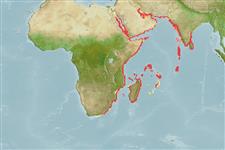Elasmobranchii (hajar och rockor) (sharks and rays) >
Rhinopristiformes (Shovelnose rays) >
Rhinidae (Wedgefishes)
Etymology: Rhynchobatus: Greek, rhingchos = snout + Greek, batis, -idos = a sting ray (Raja sp.) (Ref. 45335).
More on author: Forsskål.
Environment: milieu / climate zone / depth range / distribution range
Ekologi
marina; brackvatten revassocierade; djupintervall 1 - 75 m (Ref. 106604). Tropical; 35°N - 35°S, 22°E - 83°E
Western Indian Ocean: restricted to the Red Sea and the tropical western Indian Ocean to South Africa. Also reported from Persian Gulf (Ref. 68964). Apparently misidentified with closely related species in the northern and eastern Indian Ocean and western Pacific (however, Ref. 5978 seems to present a reliable record from western Indonesia).
Length at first maturity / Size / Vikt / Age
Maturity: Lm ?, range 177 - ? cm
Max length : 310 cm TL hane/ej könsbestämd; (Ref. 5578); publicerad maxvikt: 227.0 kg (Ref. 3919)
Short description
Bestämningsnycklar | Morfologi | Morfometri
A large guitarfish with large black eyespots on the pectoral bases, a distinctive black cross between the eyes, and rows of small white spots on the upper body; snout pointed and lower caudal lobe short (Ref. 5578). Olive-green above, white below (Ref. 5578). Mouths small and contain flattened, pavement-like teeth.
Occurs inshore and in shallow estuaries (Ref. 5578). Feeds on crabs, lobsters, bivalves, small fishes (Ref. 5578) and squids (Ref. 37816). Ovoviviparous (Ref. 50449). Takes crayfish and pilchard bait. Meat and fins sought after in Asian markets (Ref. 30573).
Life cycle and mating behavior
Könsmognad | Reproduktion | Lek | Ägg | Fecundity | Larver
Exhibit ovoviparity (aplacental viviparity), with embryos feeding initially on yolk, then receiving additional nourishment from the mother by indirect absorption of uterine fluid enriched with mucus, fat or protein through specialised structures (Ref. 50449). With 4 young, about 43-60 cm in length (Ref. 37816), born in the summer (Ref. 3919).
Compagno, L.J.V., 1986. Rhinobatidae. p. 128-131. In M.M. Smith and P.C. Heemstra (eds.) Smiths' sea fishes. Springer-Verlag, Berlin. (Ref. 3919)
IUCN Red List Status (Ref. 130435: Version 2024-1)
Threat to humans
Harmless
Human uses
Fiskeri: kommersiell; sportfisk: ja; Akvarium: Offentliga akvarier
Verktyg
Special reports
Download XML
Internet-källor
Estimates based on models
Preferred temperature (Ref.
123201): 24.5 - 29.3, mean 27.1 °C (based on 304 cells).
Phylogenetic diversity index (Ref.
82804): PD
50 = 0.5049 [Uniqueness, from 0.5 = low to 2.0 = high].
Bayesian length-weight: a=0.00372 (0.00163 - 0.00845), b=3.11 (2.91 - 3.31), in cm total length, based on LWR estimates for this (Sub)family-body shape (Ref.
93245).
Trofisk nivå (Ref.
69278): 3.6 ±0.6 se; based on diet studies.
Resiliens (Ref.
120179): Låg, lägsta populationsfördubblingstid 4,5-14 år (Fec assumed to be <100).
Prior r = 0.28, 95% CL = 0.18 - 0.42, Based on 1 data-limited stock assessment.
Fishing Vulnerability (Ref.
59153): Very high vulnerability (90 of 100).
Climate Vulnerability (Ref.
125649): High to very high vulnerability (71 of 100).
Nutrients (Ref.
124155): Calcium = 7.69 [1.43, 29.34] mg/100g; Iron = 0.324 [0.076, 0.901] mg/100g; Protein = 19.9 [17.7, 22.1] %; Omega3 = 0.0794 [, ] g/100g; Selenium = 43.4 [12.2, 120.5] μg/100g; VitaminA = 20.3 [6.7, 58.7] μg/100g; Zinc = 0.733 [0.359, 1.509] mg/100g (wet weight);
